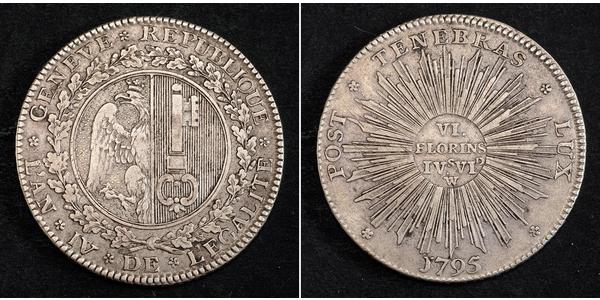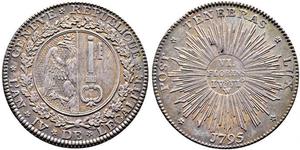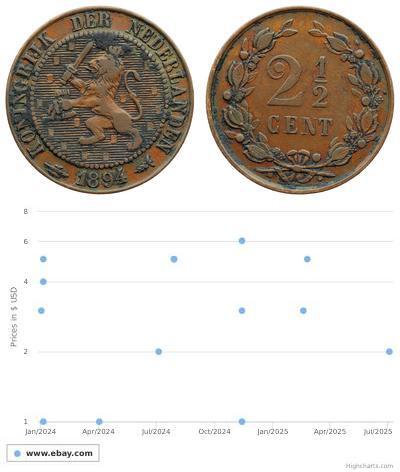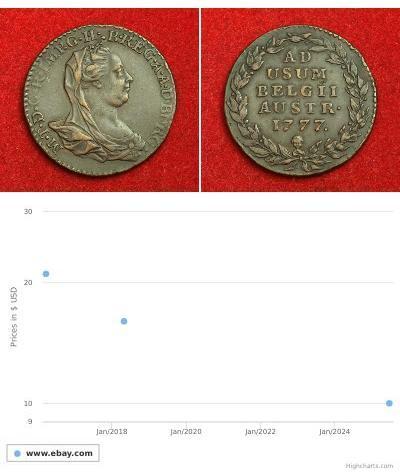6 Florin / 1/2 Thaler (售价 $344.0)
1795, Switzerland, Geneva (Canton). Silver ½ Thaler Coin. Revolutionary Coinage!
Mint Year: 1795 Mint Place: Geneva (Canton) Condition: Minor deposits, otherwise XF-AU! Reference: HMZ 2-340a, DT 1034, KM-110 ($375 in XF!). Denomination: ½ Thaler (VI Florins / IV Sols / VI Deniers) - Revolutionary Coinage! Weight: 14.93gm Diameter: 33mm Material: Silver
Obverse: Round arms of Geneva (crowned eagle / key) within wreath. Legend: GENEVE REPUBLIQUE * L'AN IV. DE L'EGALITE * ("Republic of Geneva, 4th year of the Equality (=the Revolution)!")
Reverse: Value (VI. FLORINS / IV s. VI d.) and mint master´s initial (W) within a circle of light. Motto of Geneva ("Light after darkness.") around. Legend: POST * TENEBRAS * LUX * 1795 *
For your consideration a scarce Napoleonic period influenced ½ thaler coin of Geneva, as free city, bearing french denominaitons (VI FLORINS / IV SOLS) and dating of the French Revolution (L'AN IV. DE L'EGALITE), just like we know it from french coinage of this period. A scarce and beautiful coin and a great addition!
The Atlantic Revolutions were a revolutionary wave in the late eighteenth and early nineteenth centuries. It was associated with the Atlantic World during the era from the 1760s to the 1870s. It took place in both the Americas and Europe, including the United States (1765–1783), Polish–Lithuanian Commonwealth (1788–1792), France and French-controlled Europe (1789–1814), Haiti (1791–1804), Ireland (1798) and Spanish America (1810–1825). There were smaller upheavals in Switzerland, Russia, and Brazil. The revolutionaries in each country knew of the others and to some degree were inspired by or emulated them.
From the beginning the bishopric of Geneva was a suffragan of the archbishopric of Vienne. The bishops of Geneva had the status of prince of the Holy Roman Empire since 1154, but had to maintain a long struggle for their independence against the guardians (advocati) of the see, the counts of Geneva and later the counts of the House of Savoy. In 1290 the latter obtained the right of installing the vice-dominus of the diocese, the title of Vidame of Geneva was granted to the counts of the House of Candia under count François de Candie of Chambery-Le-Vieux a Chatellaine of the Savoy, this official exercised minor jurisdiction in the town in the bishop's. In 1387 Bishop Adhémar Fabry granted the town its great charter, the basis of its communal self-government, which every bishop on his accession was expected to confirm. When the line of the counts of Geneva became extinct in 1394, and the House of Savoy came into possession of their territory, assuming after 1416 the title of Duke, the new dynasty sought by every means to bring the city of Geneva under their power, particularly by elevating members of their own family to the episcopal see. The city protected itself by union with the Swiss Federation (German: Eidgenossenschaft), uniting itself in 1526 with Berne and Fribourg.
The Protestant Reformation affected Geneva. While Bern favoured the introduction of the new teaching and demanded liberty of preaching for the Reformers Guillaume Farel and Antoine Froment, Catholic Fribourg renounced in 1511 its allegiance with Geneva. In 1532 the Roman Catholic bishop of the city was obliged to leave his residence, never to return. In 1536, the Genevans declared themselves Protestant and proclaimed their city a republic. The Protestant leader John Calvin was based in Geneva from 1536 to his death in 1564 (save for an exile from 1538 to 1541) and became the spiritual leader of the city. Geneva became a centre of Protestant activity, producing works such as the Genevan Psalter, though there were often tensions between Calvin and the city's civil authorities. Though the city proper remained a Protestant stronghold under St. Francis de Sales, a large part of the historic diocese returned to Catholicism in the early seventeenth century.
During the French Revolution (1789-1799), aristocratic and democratic factions contended for control of Geneva. In 1798, however, France, then under the Directory, annexed Geneva and its surrounding territory.
In 1802 the diocese was united with that of Chambéry. At the Congress of Vienna of 1814-15, the territory of Geneva was extended to cover 15 Savoyard and six French parishes, with more than 16,000 Catholics; at the same time it was admitted to the Swiss Confederation.
Only 1$ shipping for each additional coin purchased!

|
发布人:
anonymous 2021-04-21 |
|
||
|
||
|
||
|
||




 Deutsch
Deutsch Русский
Русский Українська
Українська English
English Italiano
Italiano Français
Français Español
Español 汉语
汉语












